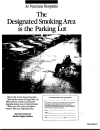"They're going to die anyway": smoking shelters at veterans' facilities
- PMID: 23409899
- PMCID: PMC3673238
- DOI: 10.2105/AJPH.2012.301022
"They're going to die anyway": smoking shelters at veterans' facilities
Abstract
Military personnel and veterans are disadvantaged by inadequate tobacco control policies. We conducted a case study of a Department of Veterans Affairs (VA) effort to disallow smoking and tobacco sales in VA facilities. Despite strong VA support, the tobacco industry created a public relations-focused grassroots veterans' opposition group, eventually pushing the US Congress to pass a law requiring smoking areas in every VA health facility. Arguing that it would be unpatriotic to deny veterans this "freedom" they had ostensibly fought for and that banning smoking could even harm veterans' health, industry consultants exploited veterans' organizations to protect tobacco industry profits. Civilian public health advocates should collaborate with veterans to expose the industry's manipulation, reframe the debate, and repeal the law.
Figures
Comment in
-
Smoking and tobacco use within the Department of Veterans Affairs.Am J Public Health. 2013 Jul;103(7):e3. doi: 10.2105/AJPH.2013.301375. Epub 2013 May 16. Am J Public Health. 2013. PMID: 23678898 Free PMC article. No abstract available.
-
Offen et al. respond.Am J Public Health. 2013 Jul;103(7):e3-4. doi: 10.2105/AJPH.2013.301388. Epub 2013 May 16. Am J Public Health. 2013. PMID: 23678918 Free PMC article. No abstract available.
References
-
- Joseph AM, Muggli M, Pearson KC, Lando H. The cigarette manufacturers’ efforts to promote tobacco to the U.S. military. Mil Med. 2005;170(10):874–880 - PubMed
-
- Bray RM, Pemberton MR, Hourani LLet al.2008 Department of Defense Survey of Health Related Behaviors Among Active Duty Military Personnel: A Component of the Defense Lifestyle Assessment Program (DLAP). Research Triangle Park, NC: RTI International; September 2009. Report No. RTI/10940-FR. Available at: http://www.tricare.mil/2008HealthBehaviors.pdf. Accessed April 30, 2012
-
- Institute of Medicine Combating Tobacco Use in Military and Veteran Populations. Washington, DC: National Academies Press; 2009 - PubMed
Publication types
MeSH terms
Substances
Grants and funding
LinkOut - more resources
Full Text Sources
Other Literature Sources
Medical


